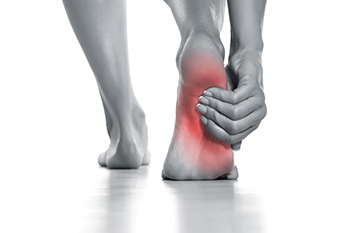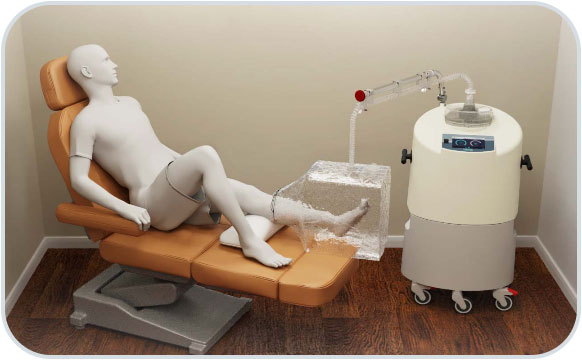Connect With Us
Blog
Items filtered by date: October 2025
Heel Pain Can Be Treated!
Foot and Ankle Injuries From Roller Skating

Roller skating demands stability, control, and quick footwork, which can place strain on the feet and ankles. Poorly fitted skating boots are a common source of discomfort, causing blisters, pressure points, and nerve irritation. Tight boots may lead to lace bite or a pinched nerve on the top of the foot, while loose boots can result in instability, cramping, and fatigue from overcompensating. Over time, these issues may contribute to more serious conditions such as plantar fasciitis, Achilles tendinitis, or metatarsal stress fractures. Malleolar bursitis may occur when pressure builds around the bony ankle area, and poor technique or muscle imbalances can worsen strain during turns and landings. A podiatrist can examine painful areas, assess footwear fit, recommend padding or custom orthotics, and offer guidance to reduce injury risk and improve comfort on skates. If you suffer from foot or ankle pain after roller skating, it is suggested that you schedule an appointment with a podiatrist for an exam and appropriate treatment options.
Sports related foot and ankle injuries require proper treatment before players can go back to their regular routines. For more information, contact one of our podiatrists of Advanced Foot and Ankle Centers, Inc.. Our doctors can provide the care you need to keep you pain-free and on your feet.
Sports Related Foot and Ankle Injuries
Foot and ankle injuries are a common occurrence when it comes to athletes of any sport. While many athletes dismiss the initial aches and pains, the truth is that ignoring potential foot and ankle injuries can lead to serious problems. As athletes continue to place pressure and strain the area further, a mild injury can turn into something as serious as a rupture and may lead to a permanent disability. There are many factors that contribute to sports related foot and ankle injuries, which include failure to warm up properly, not providing support or wearing bad footwear. Common injuries and conditions athletes face, including:
- Plantar Fasciitis
- Achilles Tendinitis
- Achilles Tendon Rupture
- Ankle Sprains
Sports related injuries are commonly treated using the RICE method. This includes rest, applying ice to the injured area, compression and elevating the ankle. More serious sprains and injuries may require surgery, which could include arthroscopic and reconstructive surgery. Rehabilitation and therapy may also be required in order to get any recovering athlete to become fully functional again. Any unusual aches and pains an athlete sustains must be evaluated by a licensed, reputable medical professional.
If you have any questions please contact our offices located in Clovis and Madera, CA . We offer the newest diagnostic and treatment technologies for all your foot and ankle needs.
Understanding Gout and Its Impact on Your Feet

Gout is a type of inflammatory arthritis caused by a buildup of uric acid crystals in the joints, commonly affecting the big toe, but also other parts of the foot and ankle. Symptoms include sudden, severe pain, redness, swelling, and warmth surrounding the affected joint. Attacks often occur at night and can last for several days, making walking and wearing shoes uncomfortable. Causes of gout include genetics, a diet high in purines, obesity, certain medications, and underlying health conditions like kidney disease. Visually, the affected joint may appear swollen and red, and the pain is often described as intense and throbbing. A podiatrist can diagnose gout through a physical examination, patient history, and blood tests to measure uric acid levels. Treatment includes medication to reduce inflammation and pain, lifestyle modifications, dietary changes, and, in some cases, joint drainage. To manage symptoms and prevent flare-ups, it is suggested that you schedule an appointment with a podiatrist.
Gout is a painful condition that can be treated. If you are seeking treatment, contact one of our podiatrists from Advanced Foot and Ankle Centers, Inc.. Our doctors will treat your foot and ankle needs.
What Is Gout?
Gout is a form of arthritis that is characterized by sudden, severe attacks of pain, redness, and tenderness in the joints. The condition usually affects the joint at the base of the big toe. A gout attack can occur at any random time, such as the middle of the night while you are asleep.
Symptoms
- Intense Joint Pain - Usually around the large joint of your big toe, and it most severe within the first four to twelve hours
- Lingering Discomfort - Joint discomfort may last from a few days to a few weeks
- Inflammation and Redness -Affected joints may become swollen, tender, warm and red
- Limited Range of Motion - May experience a decrease in joint mobility
Risk Factors
- Genetics - If family members have gout, you’re more likely to have it
- Medications - Diuretic medications can raise uric acid levels
- Gender/Age - Gout is more common in men until the age of 60. It is believed that estrogen protects women until that point
- Diet - Eating red meat and shellfish increases your risk
- Alcohol - Having more than two alcoholic drinks per day increases your risk
- Obesity - Obese people are at a higher risk for gout
Prior to visiting your podiatrist to receive treatment for gout, there are a few things you should do beforehand. If you have gout you should write down your symptoms--including when they started and how often you experience them, important medical information you may have, and any questions you may have. Writing down these three things will help your podiatrist in assessing your specific situation so that he or she may provide the best route of treatment for you.
If you have any questions, please feel free to contact our offices located in Clovis and Madera, CA . We offer the newest diagnostic and treatment technologies for all your foot care needs.
Understanding Arch Pain and How to Find Relief

Arch pain is a common foot complaint that affects people of all ages. It often feels like a burning or aching sensation in the bottom of the foot, especially in the arch area. Symptoms may worsen after long periods of standing, walking, or physical activity. Causes can include plantar fasciitis, flat feet, high arches, overuse injuries, or wearing unsupportive footwear. The arch may appear swollen, red, or tender to the touch. A podiatrist can provide an accurate diagnosis through a physical exam, gait analysis, and possibly imaging tests. Depending on the cause, treatment includes custom orthotics, stretching exercises, footwear recommendations, or anti-inflammatory medications. In more severe cases, injections or surgery may be considered. Arch pain can interfere with daily activities and overall comfort, so it is suggested that you make an appointment with a podiatrist to address the issue and restore healthy foot function.
Foot Pain
Foot pain can be extremely painful and debilitating. If you have a foot pain, consult with one of our podiatrists from Advanced Foot and Ankle Centers, Inc.. Our doctors will assess your condition and provide you with quality foot and ankle treatment.
Causes
Foot pain is a very broad condition that could be caused by one or more ailments. The most common include:
- Bunions
- Hammertoes
- Plantar Fasciitis
- Bone Spurs
- Corns
- Tarsal Tunnel Syndrome
- Ingrown Toenails
- Arthritis (such as Gout, Rheumatoid, and Osteoarthritis)
- Flat Feet
- Injury (from stress fractures, broken toe, foot, ankle, Achilles tendon ruptures, and sprains)
- And more
Diagnosis
To figure out the cause of foot pain, podiatrists utilize several different methods. This can range from simple visual inspections and sensation tests to X-rays and MRI scans. Prior medical history, family medical history, and any recent physical traumatic events will all be taken into consideration for a proper diagnosis.
Treatment
Treatment depends upon the cause of the foot pain. Whether it is resting, staying off the foot, or having surgery; podiatrists have a number of treatment options available for foot pain.
If you have any questions, please feel free to contact our offices located in Clovis and Madera, CA . We offer the newest diagnostic and treatment technologies for all your foot care needs.
Understanding Foot Drop

Foot drop is a condition that causes difficulty lifting the front part of the foot, resulting in dragging or slapping the foot while walking. This can lead to an abnormal gait and increase the risk of tripping or falling. Common symptoms include weakness or paralysis of the muscles that lift the foot, numbness, tingling, or a heavy feeling in the affected leg. Causes of foot drop include nerve injury, muscle disorders, stroke, or compression of the peroneal nerve near the knee. The foot may appear to drag or drop when lifted, and individuals may raise their knee higher than normal to avoid tripping. A podiatrist can diagnose foot drop by assessing muscle strength, nerve function, and walking patterns. Treatment options may include targeted exercises, bracing, or surgery, depending on the cause and severity. It is suggested that you make an appointment with a podiatrist to receive an accurate diagnosis and personalized treatment plan.
If you have any concerns about your feet, contact one of our podiatrists from Advanced Foot and Ankle Centers, Inc.. Our doctors can provide the care you need to keep you pain-free and on your feet.
Biomechanics in Podiatry
Podiatric biomechanics is a particular sector of specialty podiatry with licensed practitioners who are trained to diagnose and treat conditions affecting the foot, ankle and lower leg. Biomechanics deals with the forces that act against the body, causing an interference with the biological structures. It focuses on the movement of the ankle, the foot and the forces that interact with them.
A History of Biomechanics
- Biomechanics dates back to the BC era in Egypt where evidence of professional foot care has been recorded.
- In 1974, biomechanics gained a higher profile from the studies of Merton Root, who claimed that by changing or controlling the forces between the ankle and the foot, corrections or conditions could be implemented to gain strength and coordination in the area.
Modern technological improvements are based on past theories and therapeutic processes that provide a better understanding of podiatric concepts for biomechanics. Computers can provide accurate information about the forces and patterns of the feet and lower legs.
Understanding biomechanics of the feet can help improve and eliminate pain, stopping further stress to the foot.
If you have any questions please feel free to contact our offices located in Clovis and Madera, CA . We offer the newest diagnostic and treatment technologies for all your foot and ankle needs.
Top Questions Diabetic Patients Ask About Wound Care Treatment
Managing foot health is important for those living with diabetes, as diabetic foot ulcers can lead to serious complications if not addressed promptly. At Advanced Foot and Ankle Centers, Inc., we offer compassionate guidance and support. Whether you're curious about treatment options, the healing process, or prevention strategies, we will empower you with the knowledge needed to manage your foot health effectively.
Understanding Diabetic Foot Ulcers
Diabetic foot ulcers are open wounds that often appear on the soles of the feet in people with diabetes. They result from a mix of factors like nerve damage, poor circulation, and high blood sugar, all of which hinder the body's healing ability. Nerve damage can cause a loss of feeling in the feet, making it hard to notice injuries. Reduced blood flow complicates healing and raises the risk of infections.
Catching and treating these ulcers early helps avoid severe issues like infections or even amputation. Look out for signs like redness, swelling, or drainage. Seek medical help promptly if you catch any signs of a diabetic ulcer on your foot.
Common Questions About Diabetic Foot Ulcer Treatment
When you have a foot ulcer, especially as a person with diabetes, questions may arise.
How Are Diabetic Foot Ulcers Treated?
Treating diabetic foot ulcers requires a personalized approach, focusing on healing and preventing complications. A specialist will first assess the diabetic foot sores and any factors like blood sugar levels and circulation that might affect recovery.
Treatment often includes cleaning and dressing the wound to prevent infection and create a healing environment. Sometimes, removing dead tissue, known as debridement, is necessary to promote healing. Reducing pressure on the ulcer through specialized footwear or crutches is also crucial. If an infection is present, antibiotics may be needed.
What Can I Expect During the Healing Process?
Healing from a diabetic foot ulcer can vary widely from person to person. Minor ulcers might heal in a few weeks, while more severe ones could take months. Regular check-ups with your healthcare provider are essential to track progress and make necessary adjustments to your treatment plan. Keeping blood sugar levels in check impacts the healing process.
You'll be an active participant in your recovery. This means following your specialist's advice on wound care, such as keeping the ulcer clean and dry and wearing shoes that minimize pressure on the affected area. Avoid activities that might worsen the ulcer. Open communication with your healthcare team is crucial for a successful recovery.
At Advanced Foot and Ankle Centers, Inc., we focus on educating and supporting you throughout your healing journey. Our team is here to guide you through each step, helping you take charge of your recovery and work towards the best possible outcome.
How Can I Prevent Future Ulcers?
Preventing diabetic foot ulcers maintains foot health. Start with daily foot inspections to catch any signs of injury, redness, or swelling early. A mirror can help you check the soles of your feet. Keep your feet clean and moisturized, but skip applying lotion between the toes to avoid excess moisture that can lead to infections.
Choosing the right footwear is also crucial. Opt for shoes that fit well and offer good support. Avoid walking barefoot, even at home, to minimize injury risk. Your healthcare provider might suggest custom orthotics or diabetic shoes to help distribute pressure evenly across your feet.
Regular visits to a podiatrist are essential for spotting and managing potential issues early. At Advanced Foot and Ankle Centers, Inc., our specialists offer personalized advice and closely monitor your foot health.
Advanced Treatment Options at Advanced Foot and Ankle Centers, Inc.
At Advanced Foot and Ankle Centers, Inc., we offer innovative treatments to help those with diabetic foot ulcers heal more effectively. One of our key therapies is Vaporox, which uses ultrasonic mist to create a moist environment that speeds up healing and lowers infection risk. This advanced approach is part of our dedication to providing immediate and effective care.
Our specialists, including Dr. Jason Kaplan, Dr. Sergio Melara, and Dr. Amir Shalev, work closely with each patient to develop a treatment plan that meets their unique needs. Reach out to us to start managing your diabetic foot ulcer effectively. For more information or to schedule an appointment, visit our website.


